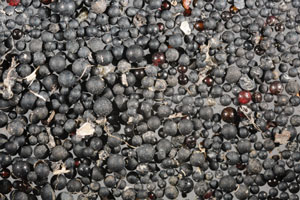Microplastic pollution discovered in St. Lawrence River sediments

Caption: Microbeads collected from St. Lawrence River sediments in summer 2013. (Photo by Guy l’Heureux)
A team of researchers from McGill University and the Quebec government have discovered microplastics (in the form of polyethylene ‘microbeads’, <2 mm diameter) widely distributed across the bottom of the St. Lawrence River, the first time such pollutants have been found in freshwater sediments. Their research was published this month in the Canadian Journal of Fisheries and Aquatic Sciences.
The microbeads likely originate from cosmetics, household cleansers, or industrial cleansers, to which they are commonly added as abrasives. Owing to their small size and buoyancy, they may readily pass through sewage treatment plants. Microplastics are a global contaminant in the world’s oceans, but have only recently been detected in the surface waters of lakes and rivers.
Researchers lowered a steel grab from a boat to collect sediment from ten locations along a 320 km section of the river from Lake St. Francis to Québec City. Microbeads were sieved from the sediment, and then sorted and counted under a microscope. “We found them in nearly every grab sample taken. The perfect multi-coloured spheres stood out from natural sediment, even though they were the size of sand grains,” said the lead author of the study, Rowshyra Castañeda, a former McGill MSc student (now at University of Toronto).
At some locations, the researchers measured over 1000 microbeads per liter of sediment, a magnitude that rivals the world’s most contaminated ocean sediments. “We were surprised to find such concentrations at the bottom of a river”, says McGill professor Anthony Ricciardi, who supervised the study. “It was previously assumed that floating microplastics are flushed through rivers to the sea. Now we have evidence that rivers can act as a sink for this pollution.”
The prevalence of microplastics in the St. Lawrence River raises the possibility that they are being consumed by fish and other animals. The environmental effects of microplastics are poorly known; but the surfaces of such particles attract chemical pollutants, including PCBs, which can be transferred to animals that ingest the plastics. “At present, we cannot predict the consequences of the accumulation of these non-biodegradable particles in freshwater ecosystems” added Ricciardi, whose lab is investigating whether the microbeads are being consumed by fish in the river.
With growing recognition of microplastics as an emerging threat to waterways, some U.S. states (Illinois, New York, Minnesota, Ohio, and California) have recently adopted or are considering legislation that bans the use of plastic microbeads in cosmetics. No such legislation has yet been proposed in Canada.
To access the full article:
R.A. Castañeda, S. Avlijas, M.A. Simard, A. Ricciardi. 2014. “Microplastic pollution in St. Lawrence River sediments”. Canadian Journal of Fisheries and Aquatic Sciences. www.nrcresearchpress.com/doi/abs/10.1139/cjfas-2014-0281
Media contacts:
Dr. Anthony Ricciardi
514-398-4089
tony.ricciardi@mcgill.ca
Rowshyra Castañeda (French interviews)
514-497-3754
rowshyra.castaneda@mail.mcgill.ca
About the Canadian Journal of Fisheries and Aquatic Sciences Published since 1901 (under various titles), the Canadian Journal of Fisheries and Aquatic Sciences (CJFAS) is one of the world’s top fisheries journals and is the primary publishing vehicle for the multidisciplinary field of aquatic sciences. CJFAS is published by Canadian Science Publishing and is part of the prestigious NRC Research Press journal collection.
Disclaimer: Canadian Science Publishing (CSP) publishes the NRC Research Press journals but is not affiliated with the National Research Council of Canada. Papers published by CSP are peer-reviewed by experts in their field. The views of the authors in no way reflect the opinions of CSP or the NRC. Requests for commentary about the contents of any study should be directed to the authors.)
Media Contact
All latest news from the category: Ecology, The Environment and Conservation
This complex theme deals primarily with interactions between organisms and the environmental factors that impact them, but to a greater extent between individual inanimate environmental factors.
innovations-report offers informative reports and articles on topics such as climate protection, landscape conservation, ecological systems, wildlife and nature parks and ecosystem efficiency and balance.
Newest articles

Nerve cells of blind mice retain their visual function
Nerve cells in the retina were analysed at TU Wien (Vienna) using microelectrodes. They show astonishingly stable behavior – good news for retina implants. The retina is often referred to…

State-wide center for quantum science
Karlsruhe Institute of Technology joins IQST as a new partner. The mission of IQST is to further our understanding of nature and develop innovative technologies based on quantum science by…

Newly designed nanomaterial
…shows promise as antimicrobial agent. Rice scientists develop nanocrystals that kill bacteria under visible light. Newly developed halide perovskite nanocrystals (HPNCs) show potential as antimicrobial agents that are stable, effective…



